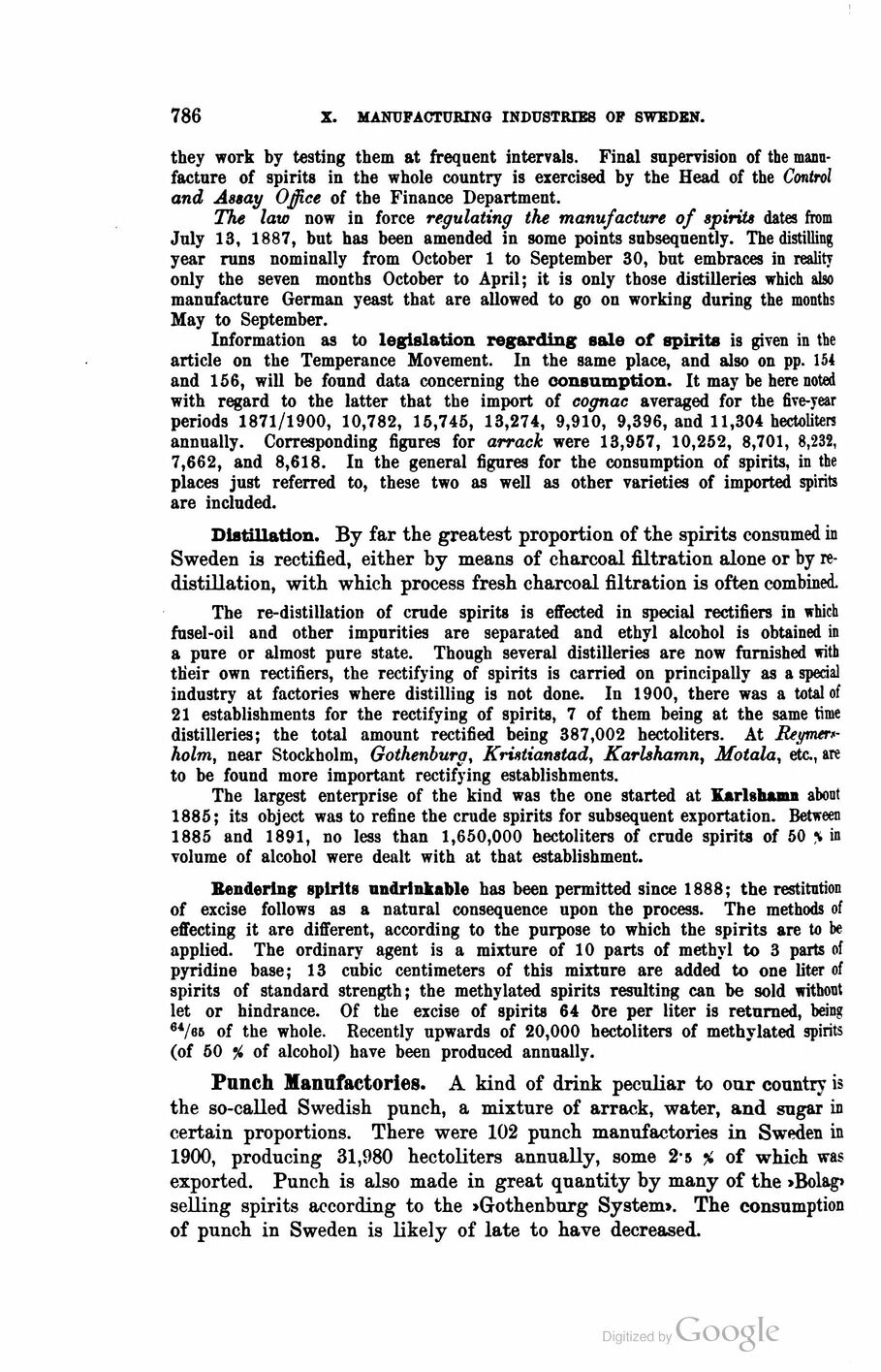
Full resolution (JPEG) - On this page / på denna sida - Second part - X. Manufacturing Industries. By Å. G. Ekstrand, Ph. D., Chief Engineer, Control Office of the Department of Finance - 1. Articles for Nutriment or Indulgence - Spirit Distilleries

<< prev. page << föreg. sida << >> nästa sida >> next page >>
Below is the raw OCR text
from the above scanned image.
Do you see an error? Proofread the page now!
Här nedan syns maskintolkade texten från faksimilbilden ovan.
Ser du något fel? Korrekturläs sidan nu!
This page has never been proofread. / Denna sida har aldrig korrekturlästs.
786
x. manufacturing industries of 8wedbn.
they work by testing them at frequent intervals. Final supervision of the
manufacture of spirits in the whole country is exercised by the Head of the Control
and Assay Office of the Finance Department.
The law now in force regulating the manufacture of spirits dates from
July 13, 1887, but has been amended in some points subsequently. The distilling
year runs nominally from October 1 to September 30, but embraces in reality
only the seven months October to April; it is only those distilleries which also
manufacture German yeast that are allowed to go on working during the months
May to September.
Information as to legislation regarding sale of spirits is given in the
article on the Temperance Movement. In the same place, and also on pp. 154
and 156, will be found data concerning the consumption. It may be here noted
with regard to the latter that the import of cognac averaged for the five-year
periods 1871/1900, 10,782, 15,745, 13,274, 9,910, 9,396, and 11,304 hectoliters
annually. Corresponding figures for arrack were 13,9 5 7, 10,25 2, 8,701, 8,232,
7,662, and 8,618. In the general figures for the consumption of spirits, in the
places just referred to, these two as well as other varieties of imported spirits
are included.
Distillation. By far the greatest proportion of the spirits consumed in
Sweden is rectified, either by means of charcoal filtration alone or by
redistillation, with which process fresh charcoal filtration is often combined.
The re-distillation of crude spirits is effected in special rectifiers in which
fusel-oil and other impurities are separated and ethyl alcohol is obtained in
a pure or almost pure state. Though several distilleries are now furnished with
their own rectifiers, the rectifying of spirits is carried on principally as a special
industry at factories where distilling is not done. In 1900, there was a total of
21 establishments for the rectifying of spirits, 7 of them being at the same time
distilleries; the total amount rectified being 387,002 hectoliters. At
Reymert-holm, near Stockholm, Gothenburg, Kristianstad, Karlshamn, Motala, etc., are
to be found more important rectifying establishments.
The largest enterprise of the kind was the one started at Karlshamn abont
1885; its object was to refine the crude spirits for subsequent exportation. Between
1885 and 1891, no less than 1,650,000 hectoliters of crude spirits of 50 > in
volume of alcohol were dealt with at that establishment.
Rendering spirits »drinkable has been permitted since 1888; the restitution
of excise follows as a natural consequence upon the process. The methods of
effecting it are different, according to the purpose to which the spirits are to be
applied. The ordinary agent is a mixture of 10 parts of methyl to 3 parts of
pyridine base; 13 cubic centimeters of this mixture are added to one liter of
spirits of standard strength; the methylated spirits resulting can be sold without
let or hindrance. Of the excise of spirits 64 öre per liter is returned, being
64/b5 of the whole. Recently upwards of 20,000 hectoliters of methylated spirits
(of 50 % of alcohol) have been produced annually.
Pnnch Manufactories. A kind of drink peculiar to our country is
the so-called Swedish punch, a mixture of arrack, water, and sugar in
certain proportions. There were 102 punch manufactories in Sweden in
1900, producing 31,980 hectoliters annually, some 2\i % of which was
exported. Punch is also made in great quantity by many of the >Bolag»
selling spirits according to the »Gothenburg System». The consumption
of punch in Sweden is likely of låte to have decreased.
<< prev. page << föreg. sida << >> nästa sida >> next page >>